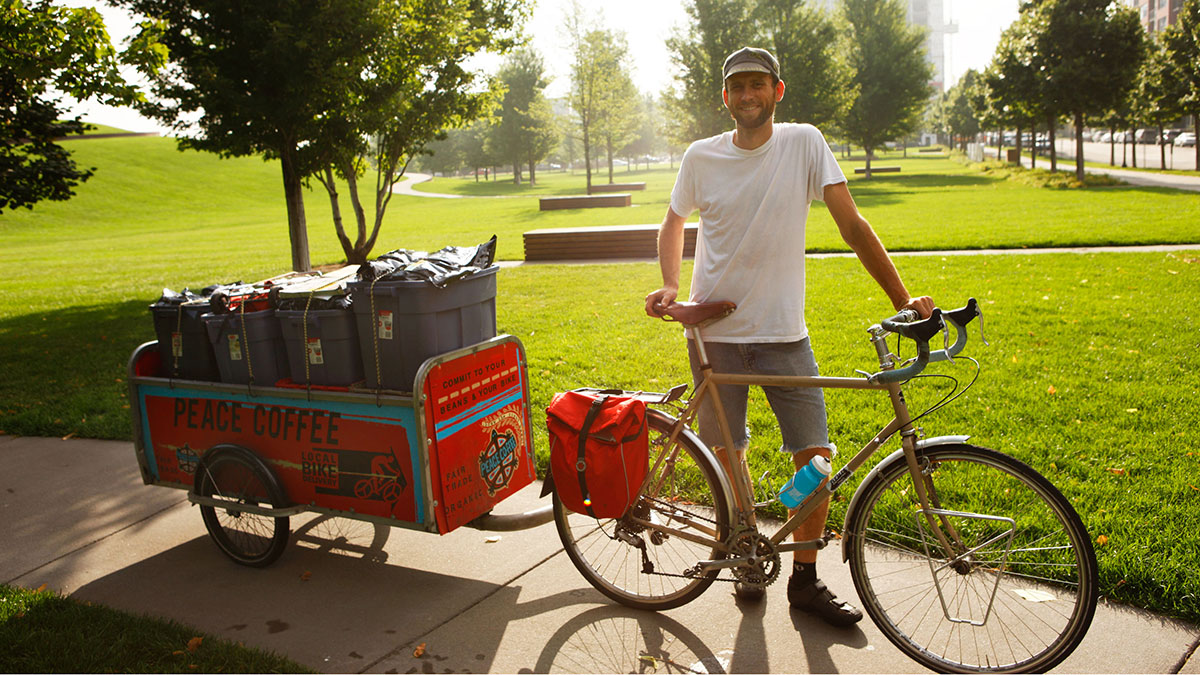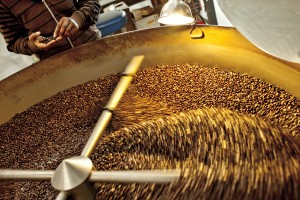Peace Coffee Stays True to Its Name

A Peace Coffee “pedaler.” Photo courtesy of Peace Coffee
I first cultivated a love for coffee in fall 2011, back when I was a student at Macalester College in St. Paul, MN, where Bon Appétit is the food service provider. As the leaves slipped from the trees and began to pile up along with the demands of academia, coffee provided both energy and warmth in frigid days, from the local coffee shop to “Café Mac.”
It was the Bon Appétit team at Macalester who first introduced me to Peace Coffee, one of our Farm to Fork suppliers. As an Environmental Studies major, my thoughts on the ethics of coffee were largely dominated by the environmental costs of shipping the beans to the Midwest, and the impact of dairy creamer and/or its corresponding soy substitutes. But tracing the full supply chain leads to a much more intimate understanding of how and why our coffee consumption practices matter. The genesis story of Peace Coffee is one impeccable example of how important and rewarding it can be to follow a product all the way back to its beginnings.
In the early ’90s, representatives from an organization called the Institute for Agriculture and Trade Policy (IATP) traveled to Mexico to meet with local coffee growers and start a discussion around the disconnect between small farmers and the often volatile state of coffee in the United States. Farmers expressed that they felt disconnected from the American market, and worried that they did not always receive a fair price for their beans. The disconnect goes even further, as most coffee growers never even get to try the drink made from the product of their beans.
Shortly after returning from this trip, the IATP team received a call from the port authority in Los Angeles, notifying them that a 38,000-pound shipment of coffee beans was waiting for them! Fortuitously, IATP used this misunderstanding as an immediate impetus to start what is now Peace Coffee.
At first, the company sold coffee almost exclusively by bike, “pedaling” their fairly traded coffee door to door. As someone totally entranced by bike-courier culture and concurrently dependent on coffee, this business model is close to my ideal of sustainability. And I’m not alone in my awe! In the urban but still solidly Midwestern community of the Twin Cities, strong allegiance to a company built around socially responsible policies has blossomed.

The interior of Peace Coffee
Today, Peace Coffee stays true to its roots: it sources all of its coffee from cooperatives made up of an average of 18 farmers each, from many countries. Each farmer operates on a property of less than 11 acres, and coffee is not their only crop. Farmers also grow bananas, chocolate, and more, in a truly comprehensive example of diverse farming. The layering of crops in a forested environment also leads Peace Coffee to be designated “shade grown.” Shade-grown coffee typically doesn’t require many pesticides, herbicides, or chemical fertilizers. This paints a completely different picture than coffee in a monocrop. In an environment with a layered canopy, biodiversity can be high amongst the shade trees. Peace Coffee has a great reverence for the process and tradition of growing coffee, the art of which is often lost when companies form a myopic view of profit.

Though Peace Coffee has expanded enormously, they have remained faithful to their name. Their buying power has allowed them to sell more fairly traded coffee in the state of Minnesota and beyond. Pedaling is still central to their business model, with two full-time bike couriers moving coffee around St. Paul and Minneapolis. These couriers not only maintain a sustainable business model, but also serve as a roaming reminder of Peace Coffee’s mission and commitment to honoring farmers’ process by maintaining care and respect through every step of the supply chain. To stay connected with coffee growers, Peace Coffee spends time traveling to their land. When I visited, I was told that a master roaster was away on a trip to South America, where he would be thanking farmers for the beautiful beans they grew and showing them the strange process Americans use to turn the beans into the coffee we all know and love.
Following the tour, I seem to be seeing Peace Coffee everywhere. Of course the Bon Appétit teams at Carleton, Saint Olaf, and Macalester serve it, but I also see the name on my housemates’ shelves in our shared cupboards, and on the shirts of cyclists riding past my porch. Peace Coffee is certainly a staple for the ethically minded Minnesotan consumer, and I am so excited to see their work and following continue to grow as they transform the coffee industry parallel to Bon Appétit in the food industry.